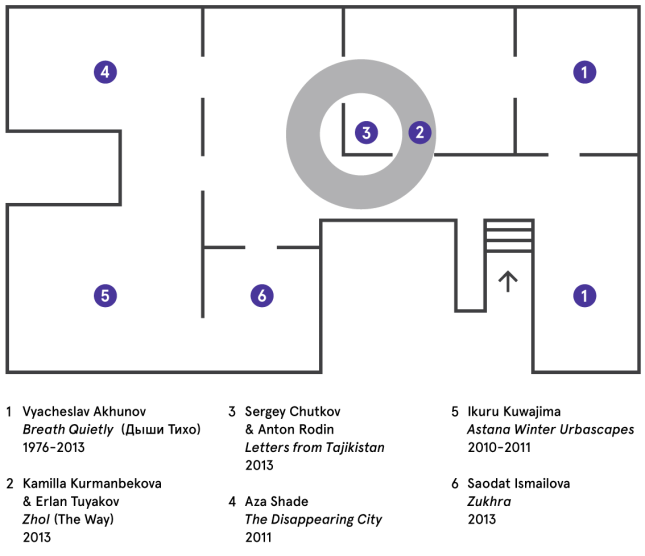www.cap2013.net/en
In our curatorial project for the International Art Exhibition – la Biennale di Venezia 2013, we recontextualize this poem to current day Central Asia, employing the key of the metaphorical to address the current socio-political context in the region and the issue of artistic agency. We aim to broaden the political debate in the region by raising questions rather than proposing statements. One of the questions we pose, is: How can the specificity of the local political and artistic context be approached in a way that transgresses common assumptions about authority and power?
The exhibition brings together visual reflections on the current socio-political situation of the region through the metaphor of winter. Winter represents a social, political and cultural climate in which an analytical or critical public discourse is frozen, or nearly absent. However, it bears the potential to develop into spring – a more vibrant public debate based on openness and participation.
In the first years after the dissolution of the USSR in 1991, the newly gained independence of the Central Asian republics gave rise to hopes for a free and fair society. However, the collapsed economy inherited from the Soviet Union and the abrupt transition to a neo-liberal market economy left these countries in an extreme state of disarray. The authorities of the newly founded republics promoted the idea of “economy first, democracy later” which, under these circumstances, became universally accepted. Evidently, later never arrived. Today, it is not in the interest of the powers in charge to allow for a vibrant public debate or a broad spectrum of voices to be heard in the decision-making processes. Rather, their aim is to sustain a state of general silence. This state of silence is usually covered up by the ideological mantra of stability – a phenomenon characteristic for most post-Soviet states.
As regards the artistic and cultural sphere in the region of Central Asia, it is characterized by a lack of institutions such as exhibition spaces and platforms for art education promoting critical thinking. This creates a feeling of alienation amongst the artists who fail to engage in public discourse and face the social challenges in their respective countries.
The project seeks to engage a variety of practices within the exhibition, the publication and a parallel program of lectures, film screenings and conferences in Central Asia, Venice and Oslo. Our hope is to serve as a catalyst for a genuinely open public debate on issues such as the relation between art and power structures, its potential to have an impact on society and possible strategies that artists can follow under precarious conditions and in oppressive times, as well as other issues currently pertinent to the region. With the active participation of Central Asian as well as international contributors, we hope to arrive at a deeper understanding of the current socio-political situation in the region, raise new questions and discover alternative ways to move beyond the state of stagnation we experience there today.
Selected through an open call for the cultural practitioners – artists, poets, writers, activists and others involved in cultural production were invited to submit their proposals – the works in the exhibition address a variety of questions relevant to Central Asian realities.
Artists:
Vyacheslav Akhunov’s site-specific installation Breathe Quietly was originally sketched in 1976 as a public monument which was never realized. A set of words in Cyrillic characters portrays a social environment and invites us to look at the present situation in Uzbekistan through the lens of the Soviet period. By exhibiting this piece today, approximately 40 years later, and under different social and political structures, the artist establishes a parallel with present-day Uzbekistan and asks us to look at similarities and differences between those different realities
Anton Rodin and Sergey Chutkov will present a joint project depicting social patterns of dissens and affinity in Tajikistan through the interpretation of written letters. Letters from Tajikistan will show disparities as well as similarities between individuals from various social, ethnic and religious backgrounds. Using the letters they receive, the artists will construct a semantic map highlighting issues of relevance to various strata of contemporary Tajik society.
The video installation Zukhra by Saodat Ismailova and the film The Disappearing City by Aza Shade explore the role of women in contemporary Central Asia where tradition still plays a major role in defining one’s position in society.
Astana’s Winter Urbanscapes, a series of photographs by Ikuru Kuwajima, and the site-specific installation entitled Zhol (The Way) by Kamilla Kurmanbekova and Erlan Tuyakov explore the field of architecture as subject to appropriation by ideology. While Kuwajima explores the recent architectural developments in Kazakhstan’s new capital Astana, Kurmanbekova and Tuyakov reinterpret the yurt, an archetypically nomadic structure which has recently been appropriated by the state for the political project of constructing a sense of national identity based on tradition.
Farukh Kuziev’s work will be presented in the publication accompanying the exhibition. His work is based on a collective effort by artists from Tajikistan and draws connections between the poor infrastructure in the country and social tensions arising when, in the winter, people suffer from discomfort due to the lack of electricity. Kuziev will show a series of works that feature the answers of artists to the question: “What work would you produce if you had total freedom of action and expression ?”
Ayatgali Tuleubek and Tiago Bom

